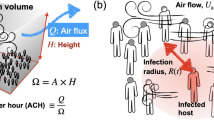Abstract
The spreading of a disease largely occurs in buildings or in collective transport. The microenvironment flow processes around people contribute to the cross-infection risk, for example when two persons are standing close to each other. The cross-infection risk is also dependent on the macro-environment e.g., distribution of velocity and turbulence in the room, particularly when the background airflow is strong. The surrounding temperature and the presence of a vertical temperature gradient can also modify airflows in the microenvironment and subsequently influence the cross-infection risk. This work is based on a fully mixed flow in a room without a vertical temperature gradient, considering different room temperatures. Exhalation flow and aerosol distribution are studied by smoke experiments and the cross-infection risk is expressed as concentration in the susceptible breathing zone normalized by the concentration in the room.
Access this chapter
Tax calculation will be finalised at checkout
Purchases are for personal use only
Similar content being viewed by others
References
Abkarian M, Mendez S, Xue N, Yang F, Stone HA (2020) Speech can produce jet-like transport relevant to asymptomatic spreading of virus. Proc Natl Acad Sci USA 117(41):25237–25245
Baturin VVE (1972) Fundamentals of industrial ventilation. Pergamon Press, Oxford
Berlanga F, Liu L, Nielsen PV, Jensen RL, Olmedo I, Adana MRD (2020) Influence of the geometry of the airways on the characterization of exhalation flows. Comparison between two different airway complexity levels performing two different breathing functions. Sustain Cities Soc 53(101874)
Bjørn E (1999) Simulation of human respiration with breathing thermal manikin. In: Proceedings of the third international meeting on thermal manikin testing, national institute for working life, Stockholm, Sweden, pp 78–81
Bjørn E, Nielsen PV (2002) Dispersal of exhaled air and personal exposure in displacement ventilated rooms. Indoor Air 12(3):147–164
Brohus H, Nielsen PV (1996) Personal exposure in displacement ventilated rooms. Indoor Air 6(3):157–167
Chen W, Zhang N, Wei J, Yen HL, Li Y (2020) Short-range airborne route dominates exposure of respiratory infection during close contact. Build Environ 176(106859)
Gupta JK, Lin C-H, Chen Q (2010) Characterizing exhaled airflow from breathing and talking. Indoor Air 20(1):31–39
Ji Y, Qian H, Ye J, Zheng X (2018) The impact of ambient humidity on the evaporation and dispersion of exhaled breathing droplets: a numerical investigation. J Aerosol Sci 115:164–172
Liu F, Zhang C, Qian H, Zheng X, Nielsen PV (2019) Direct or indirect exposure of exhaled contaminants in stratified environments using an integral model of an expiratory jet. Indoor Air 29:591–603
Liu L, Nielsen PV, Jensen RL, Xu C, Li Y (2014) Interpersonal transport of droplet nuclei among three manikins in a full-scale test room. In: ASHRAE Transactions, ASHRAE Papers CD: 2014 ASHRAE Winter Conference. ISSN: 1088–8586
Naunheim MR, Bock J, Doucette PA, Hoch M, Howell I, Johns MM, Johnson AM, Krishna P, Meyer D, Milstein CF, Nix J, Pitman MJ, Robinson-Martin T, Rubin AD, Sataloff RT, Sims HS, Titze IR, Carroll TL (2021) Safer singing during the SARS-CoV-2 pandemic: what we know and what we don’t. J Voice 35(5):765–771
Nielsen PV, Xu C (2022) Multiple airflow patterns in human microenvironment and the influence on short-distance airborne cross-infection—a review. Indoor built environ., special issue: prevention and control of COVID-19 transmission in the indoor environment
Nielsen PV, Jensen RL, Litewnicki M, Zajas JJ (2009) Experiments on the microenvironment and breathing of a person in isothermal and stratified surroundings. In: Healthy buildings: 9th international conference and exhibition, September 13–17, 2009, Syracuse, NY USA
Nielsen PV, Zajas JJ, Litewnicki M, Jensen RL (2014) Breathing and cross-infection risk in the microenvironment around people. In: ASHRAE transactions, ASHRAE papers CD: 2014 ASHRAE winter conference, vol 120. ISSN: 1088–8586
Olmedo I, Nielsen PV, Adana MRD, Jensen RL, Grzelecki (2012) Distribution of exhaled contaminants and personal exposure in a room using three different air distribution strategies. Indoor Air, 64–76
Villafruela JM, Olmedo I, Adana MRD, Méndez C, Nielsen PV (2013) CFD analysis of the human exhalation flow using different boundary conditions and ventilation strategies. Build Environ 62:191–200
Zhang C, Nielsen PV, Liu L, Sigmer ET, Mikkelsen SG, Jensen RL (2022) The source control effect of personal protection equipment and physical barrier on short-range airborne transmission. Build Environ 211(108751)
Author information
Authors and Affiliations
Corresponding author
Editor information
Editors and Affiliations
Rights and permissions
Copyright information
© 2023 The Author(s), under exclusive license to Springer Nature Singapore Pte Ltd.
About this paper
Cite this paper
Nielsen, P.V. et al. (2023). Cross-Infection Risk Between Two People in Different Temperature Surroundings Studied by Aerosol Dynamics. In: Wang, L.L., et al. Proceedings of the 5th International Conference on Building Energy and Environment. COBEE 2022. Environmental Science and Engineering. Springer, Singapore. https://doi.org/10.1007/978-981-19-9822-5_177
Download citation
DOI: https://doi.org/10.1007/978-981-19-9822-5_177
Published:
Publisher Name: Springer, Singapore
Print ISBN: 978-981-19-9821-8
Online ISBN: 978-981-19-9822-5
eBook Packages: EngineeringEngineering (R0)




